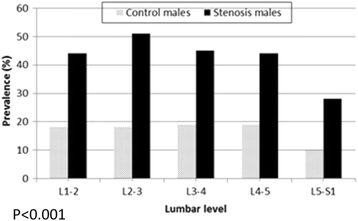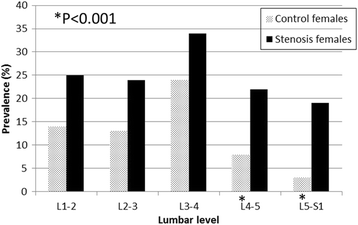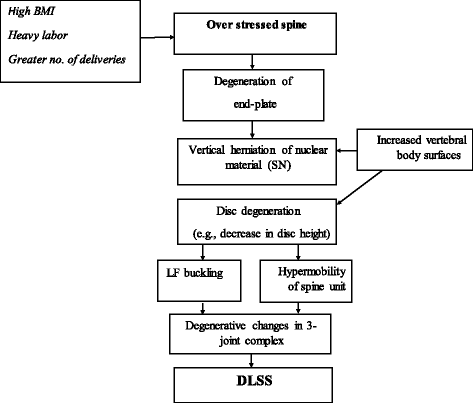In the quest for degenerative lumbar spinal stenosis etiology: the Schmorl's nodes model
- PMID: 28424050
- PMCID: PMC5397788
- DOI: 10.1186/s12891-017-1512-6
In the quest for degenerative lumbar spinal stenosis etiology: the Schmorl's nodes model
Abstract
Background: Degenerative lumbar spinal stenosis (DLSS) is a common health problem in the elderly and usually associated with three-joint complex degeneration. Schmorl's nodes (SNs) are described as vertical herniation of the disc into the vertebral body through a weakened part of the end plate that can lead to disc degeneration. Since SNs can harm the spine unit stability, the association between DLSS and SNs is expected. The aim of this study is to shed light on the relationship between degenerative lumbar spinal stenosis and SNs.
Methods: Two groups of individuals were studied: the first included 165 individuals with DLSS (age range: 40-88, sex ratio: 80 M/85 F) and the second 180 individuals without spinal stenosis related symptoms (age range: 40-99, sex ratio: 90 M/90 F). The presence or absence of SNs on the cranial and caudal end plate surfaces at the lumbosacral region (from L1 to S1 vertebra) was recorded, using CT images (Brilliance 64 Philips Medical System, Cleveland Ohio, thickness of the sections was 1-3 mm and MAS, 80-250). Chi-Square test was taken to compare the prevalence of SNs between the study groups (control and stenosis) by lumbar disc level, for each gender separately. Multivariable logistic regression analysis was also used to determine the association between DLSS and SNs.
Results: The prevalence rate of SNs was significantly greater in the stenosis males (L1-2 to L5-S1) and females (L4-5 and L4-S1) compared to their counterparts in the control (P < 0.001). In addition, the presence of SNs in both males and females was found to increase the likelihood for DLSS.
Conclusions: Our results indicate that SNs prevalence is significantly greater in the DLSS group compared to the control. Furthermore, SNs are strongly associated with DLSS.
Keywords: Computerized tomography (CT); Degenerative lumbar spinal stenosis; Schmorl’s nodes.
Figures





References
-
- Kirkaldy-Willis WH, McIvor GW. Spinal stenosis. Clin Orthop. 1974;115:2–144. - PubMed
Publication types
MeSH terms
Supplementary concepts
LinkOut - more resources
Full Text Sources
Other Literature Sources
Medical

